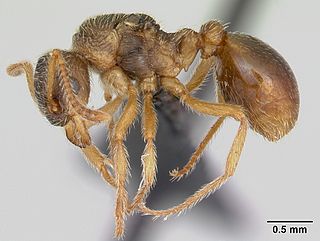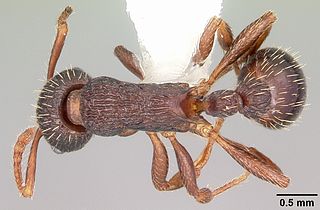
The large blue is a species of butterfly in the family Lycaenidae. The species was first defined in 1758 and first recorded in Britain in 1795. In 1979 the species became mostly extinct in Britain but has been successfully reintroduced with new conservation methods. The species is classified as "near threatened" on the IUCN Red List of Threatened Species. Today P. arion can be found in Europe, the Caucasus, Armenia, western Siberia, Altai, north-western Kazakhstan and Sichuan.

Myrmica rubra, also known as the common red ant or erroneously the European fire ant, is a species of ant of the genus Myrmica, found all over Europe and is now invasive in some parts of North America and Asia. It is mainly red in colour, with slightly darker pigmentation on the head. These ants live under stones and fallen trees, and in soil. They are aggressive, often attacking rather than running away, and are equipped with a stinger, though they lack the ability to spray formic acid like the genus Formica.

Phengaris alcon, the Alcon blue or Alcon large blue, is a butterfly of the family Lycaenidae and is found in Europe and across the Palearctic to Siberia and Mongolia.

Myrmica is a genus of ants within the subfamily Myrmicinae. It is widespread throughout the temperate regions of the Holarctic and high mountains in Southeast Asia.
Myrmica cadusa is a species of ant. Myrmica cadusa differs from similar ants in the genus Myrmica by the external shape of the antennal socket, which is jar shaped. They forage on the ground surface. Myrmica are unique from other types of ants in many ways. These are their oval head, rounded clypeus, prominent frontal lobes and in most species, a strongly developed propodeal spine with two large nodes.

Myrmica colax is a species of ant, originally described by Cole as Paramyrmica colax. Until now, it is only known from its type locality in the Davis Mountains, Texas, USA. He found M. colax in a M. striolagaster colony and considers the two species quite similar in morphology. This suggests M. colax might be an inquiline.
Barry Bolton is an English myrmecologist, an expert on the classification, systematics, and taxonomy of ants, who long worked at the Natural History Museum, London. He is known especially for monographs on African and Asian ants, and for encyclopaedic global works, including the Identification Guide to Ant Genera (1994), A New General Catalogue of Ants of the World, Synopsis and Classification of Formicidae (2003), and Bolton's Catalogue of Ants of the World: 1758-2005 (2007). Now retired, Bolton is a Fellow of the Royal Entomological Society and Myrmecologist, Biodiversity Division, Department of Entomology, Natural History Museum, London.

Phengaris rebeli, common name mountain Alcon blue, is a species of butterfly in the family Lycaenidae. It was first found and described in Styria, Austria, on Mount Hochschwab around 1700. Although it was initially classified as a subspecies of P. alcon, a European researcher, Lucien A. Berger, designated it as a separate species in 1946. Genetic similarities between P. rebeli and P. alcon have led many researchers to argue that the two are the same species and differences are due to intraspecific variation.

The scarce large blue is a species of butterfly in the family Lycaenidae. It is found in Austria, Slovenia, Croatia, the Czech Republic, France, Georgia, Germany, Hungary, Italy, Japan, Kazakhstan, Mongolia, the Netherlands, Poland, Romania, Russia, northern Serbia, Spain, Switzerland, and Ukraine and East across the Palearctic to Japan. The species was first described by Johann Andreas Benignus Bergsträsser in 1779.

Myrmica sabuleti is a species of ant in the genus Myrmica. The species is indigenous to Europe, and most colonies are polygynous. Caterpillars of the large blue butterfly parasitically prey on this ant. The caterpillar hatches on Wild Thyme buds and then at the fourth-instar stage tricks the ants into believing it is one of their own larvae. The worker ants then carry the caterpillar to their nest, where it feeds on the ant grubs for 10 months before pupating and emerging as a butterfly.

Myrmica ruginodis is a species of ant that lives in northern parts of Europe and Asia. It is very similar to M. rubra, but has a more northerly and higher-altitude distribution. Overwintering larvae may become either workers or queen ants, with up to 20 queens living in a colony of up to 2,500 individuals. Two subspecies are recognised, differing in the relative size of the queen.

Myrmica scabrinodis scabrinodis is a subspecies of ant that can be found everywhere in Europe except for Andorra, Bosnia and Herzegovina, Canary Islands, Croatia, Iceland, Malta, Monaco, Madeira, Monaco, San Marino, Slovenia, and Vatican City. It is unique in that it reproduces by ejecting pheromones from its postpetiole directly into the mandibles of its mate. Female ants of this species can also reproduce through thelytokous parthenogenesis, but, unlike most ant species during this process, the individual will rupture the membrane of the gaster, causing a burst of secretions containing their offspring in addition to acetophenones and other chemicals.

Myrmica schencki is a species of ant in the genus Myrmica.

Myrmica karavajevi is a workerless, socially parasitic ant species: it is widely distributed across Europe. It lives in nests of other species that inhabit warm and humid habitats.

Myrmica salina is a species of ant belonging to the genus Myrmica. They have a wide distribution in Europe and Siberia, as well as being abundant to several former republics of the Soviet Union, where their preferred habitats are relatively wet halophyte biotopes. Ruzsky first described the first specimen of the species in 1905.
Myrmica obscurata is a species of ant of the genus Myrmica. It is found in Sri Lanka.
Agastomyrma is an extinct genus of formicid in the ant subfamily Myrmicinae known from the fossil species Agastomyrma laticeps found in eastern Asia.

Myrmica spatulata is a species of ant in the family Formicidae. It is found in the forests of the middle and eastern part of the United States.















